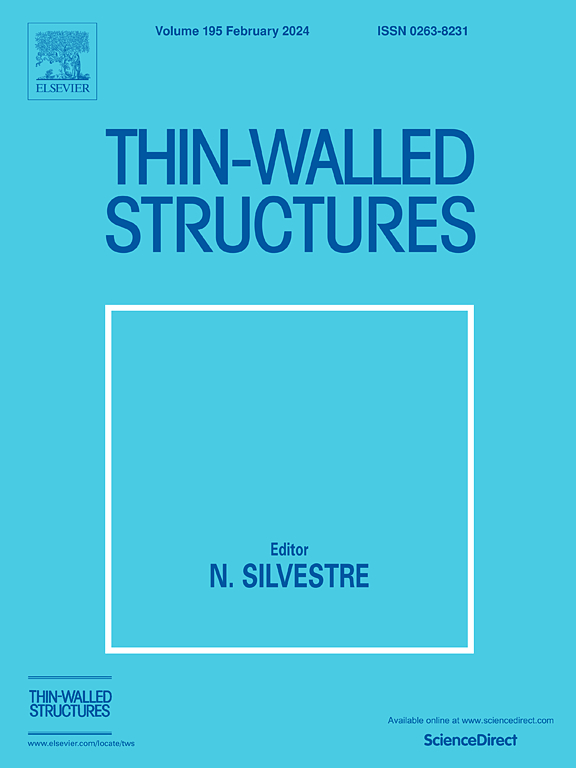Impact-resistant performance of DVST sandwich panel under low-velocity impact and numerical cases study of protective effect on RC column
IF 5.7
1区 工程技术
Q1 ENGINEERING, CIVIL
引用次数: 0
Abstract
A double vertical steel tube (DVST) sandwich panel, with a core layer composed of inner and outer vertical circular hollow steel tubes, was proposed as a sacrificial cladding to mitigate the damage induced by impact loading to reinforced concrete (RC) column. Through experimental tests and numerical simulations, dynamic behaviors of the DVST sandwich panel under low-velocity impact was evaluated. The impacts of varying inner tube diameters and single-layer versus double-layer configurations on the failure mode and the time-history of impact forces of the DVST sandwich panels were examined. The results indicated that the steel tube of the upper layer in double-layer DVST sandwich panels played a crucial role in absorbing impact energy. Additionally, the effectiveness of the DVST sandwich panel as a sacrificial cladding for RC columns under low-velocity impact was investigated. The findings revealed that the presence of the DVST sandwich panel reduced the energy absorbed by the RC column by approximately 60.1 %, effectively preserving the integrity of the column while minimizing deformation and damage.
低速冲击下 DVST 夹层板的抗冲击性能及对 RC 柱的保护作用的数值案例研究
研究人员提出了一种双垂直钢管(DVST)夹层板,其核心层由内外垂直圆形空心钢管组成,作为一种牺牲包层,可减轻钢筋混凝土(RC)柱在冲击荷载作用下受到的破坏。通过实验测试和数值模拟,对 DVST 夹层板在低速冲击下的动态行为进行了评估。研究了不同内管直径、单层与双层结构对 DVST 夹层板失效模式和冲击力时间历程的影响。结果表明,在双层 DVST 夹层板中,上层钢管在吸收冲击能量方面起着至关重要的作用。此外,还研究了 DVST 夹层板在低速冲击下作为 RC 柱牺牲包层的有效性。研究结果表明,DVST 夹层板的存在使 RC 柱吸收的能量减少了约 60.1%,在最大限度地减少变形和损坏的同时有效地保持了柱子的完整性。
本文章由计算机程序翻译,如有差异,请以英文原文为准。
求助全文
约1分钟内获得全文
求助全文
来源期刊

Thin-Walled Structures
工程技术-工程:土木
CiteScore
9.60
自引率
20.30%
发文量
801
审稿时长
66 days
期刊介绍:
Thin-walled structures comprises an important and growing proportion of engineering construction with areas of application becoming increasingly diverse, ranging from aircraft, bridges, ships and oil rigs to storage vessels, industrial buildings and warehouses.
Many factors, including cost and weight economy, new materials and processes and the growth of powerful methods of analysis have contributed to this growth, and led to the need for a journal which concentrates specifically on structures in which problems arise due to the thinness of the walls. This field includes cold– formed sections, plate and shell structures, reinforced plastics structures and aluminium structures, and is of importance in many branches of engineering.
The primary criterion for consideration of papers in Thin–Walled Structures is that they must be concerned with thin–walled structures or the basic problems inherent in thin–walled structures. Provided this criterion is satisfied no restriction is placed on the type of construction, material or field of application. Papers on theory, experiment, design, etc., are published and it is expected that many papers will contain aspects of all three.
 求助内容:
求助内容: 应助结果提醒方式:
应助结果提醒方式:


